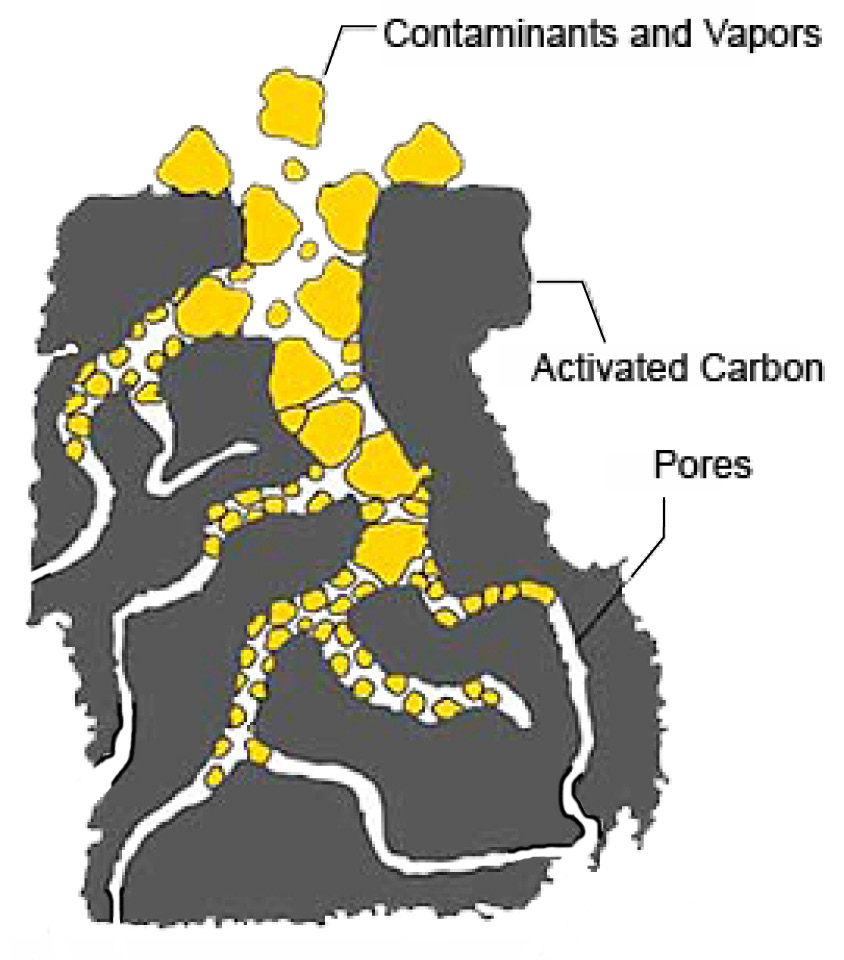What Is Activated Carbon Treatment?
Activated carbon is a material used to filter harmful chemicals from contaminated water and air. It is composed of black granules of coal, wood, nutshells or other carbon-rich materials. As contaminated water or air flows through activated carbon, the contaminants sorb (stick) to the surface of the granules and are removed from the water or air. Granular activated carbon or “GAC” can treat a wide range of contaminant vapors including radon and contaminants dissolved in groundwater, such as fuel oil, solvents, polychlorinated biphenyls (PCBs), dioxins, and other industrial chemicals, as well as radon and other radioactive materials. It even removes low levels of some types of metals from groundwater.
How Does It Work?
Activated carbon treatment generally consists of one or more columns or tanks filled with GAC. Contaminated water or vapors are usually pumped through a column from the top down, but upward flow is possible. As the contaminated water or air flows through the GAC, the contaminants sorb to the outer and inner surfaces of the granules. The water and air exiting the container will be cleaner. Regular testing of exiting water or air is conducted to check contaminant levels. If testing shows that some contaminants remain, the water or air may need to be treated again to meet the treatment levels.
The GAC will need to be replaced when the available surfaces on the granules are taken up by contaminants and additional contaminants can no longer sorb to them. The “spent” GAC may be replaced with fresh GAC or “regenerated” to remove the sorbed contaminants. To regenerate spent GAC, it is usually sent to an offsite facility where it is heated to very high temperatures to destroy the contaminants. If a lot of GAC needs to be regenerated, equipment to heat the GAC and remove the sorbed contaminants can be brought to the site.Depending on the site, treated groundwater may be pumped into a nearby stream or river or back underground through injection wells or trenches. At some sites, a sprinkler system can distribute the water over the ground surface so that it seeps into soil. The water also may be discharged to the public sewer system for further treatment at a sewage treatment plant.

How Long Will It Take?
It only takes a few minutes for water or vapors to pass through an activated carbon filter. However, the time it takes to clean up a site with activated carbon treatment will depend on how long it takes to bring all the contaminated groundwater or contaminant vapors to the ground surface for treatment. This can take several months to many years. Treatment may take longer where:
• Contaminant concentrations are high or the source of dissolved contaminants has not been
completely removed.
• The volume of contaminated groundwater or vapors is large.
• Treatment of groundwater or vapors involves several other cleanup methods.
These factors vary from site to site.
Is Activated Carbon Treatment Safe?
Activated carbon treatment is safe to use. Treated water is sampled and analyzed regularly to ensure that the carbon continues to adequately sorb contaminants. If concentrations start to increase in the treated water, the carbon is reactivated or replaced. The tanks are cleaned or replaced with care to avoid releasing contaminants. Larger filters are often preferred because they do not have to be replaced as often as small ones. When treatment is complete, the used carbon may contain hazardous contaminants that require special handling and disposal at a hazardous waste facility.
How Might It Affect Me?
Activated carbon treatment generally will not disrupt the surrounding community. Initial construction of systems to extract groundwater or contaminant vapors from the ground may involve the use of heavy equipment. This may cause a temporary increase truck traffic in the neighborhood as equipment is brought to the site or when carbon tanks are exchanged. However, the treatment system itself is not particularly noisy while running. Depending on the amount of groundwater or vapors that need to be treated, tanks of activated carbon can range in size from a 55-gallon drum to a tank that is 20 feet tall and 10 feet or more in diameter.
Why Use Activated Carbon Treatment?
Activated carbon is the most commonly used approach to treating groundwater. It is also used to treat contaminant vapors removed from
contaminated soil and groundwater by soil vapor extraction and other cleanup methods.
Activated carbon units can be brought to the site and set up relatively quickly.